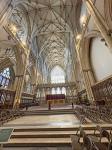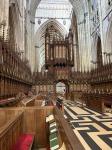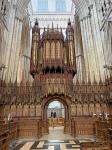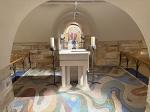Wednesday 21st May 2025
On a recent photographic trip in the Yorkshire Dales earlier this year one of my cameras stopped working, fortunately I still had another camera with me so all was not lost, anyway, I took the camera in to a specialist repair shop in York on my return and eight weeks later I got a call to say the camera had been successfully repaired and was ready to collect. Not needing an excuse to visit York I went to collect my camera and whilst there popped into York Minster for a browse round. I always enjoy a look round the minster and should visit more often than I do.
I arrived at the Minster just after 9.30am, fortunately, my entrance ticket from visiting late last year was still valid for this morning’s visit. There were quite a few visitors in already but that said I had a very pleasant walk through this beautiful Medieval place of worship. Leaving the West door behind me I headed along the North side of the Nave to the North Transept, dominated by the huge ‘Five Sisters Window’ - the only memorial in the country to women of the British Empire who lost their lives during the First World War. The window is one of the oldest medieval windows, which contains a plain grey/green glass called ‘grisaille,’ when the window was first installed it would have been much brighter, unfortunately due to previous restorations and the passage of time it has a very much plain and darkened appearance today. I always stop and marvel whilst standing in the ‘Central Tower,’ the highest point in York and large enough to fit the Leaning Tower of Pisa inside at the hight of the ceiling and the intricate pattern on the roof. It was originally built between around 1220 and 1253, and it is the only part of the current cathedral to have collapsed, which happened in 1407 due to soft soil beneath its foundations.
The ‘Quire Screen’ which separates the Nave from the Quire is a work of art by skilled craftsmanship, it dates from around 1450 and is decorated with the kings who reigned during the time the Minster was built, it is also a popular meeting spot for the visitors. Looking across to the South Transept a lot of scaffolding had been erected up to the height of the Rose Window, this area of the minster suffered considerable damage when it was struck by lightning in 1984, the resulting fire destroyed much of the roof and buttresses in this area which have since been completely restored including the Rose window. Heading back passing the small café which has appeared in the north transept since my last visit, I walked around the corner to ‘The Chapter House’ a place I am sure many visitors will miss, it contains some of the Minster’s finest carvings and in 1297 was used as the location for the Parliament of King Edward I. The octagonal space dates from the 1280s and its magnificent vaulted ceiling is supported by timbers in the roof, instead of a central column. I always try to take a photograph of this ceiling to capture its beauty. After leaving the Chapter House I retraced my steps back into the Central Tower area and headed into the Quire. Built between 1361 and 1420s, unfortunately, much of the original structure was destroyed in a fire started deliberately in 1829, fortunately, it was faithfully recreated in the 1830’s. This is a beautiful part of the Minster, where the services are sung. There is so much to see and admire, along the sides are the stalls of the Canons, each having a badge or plaque showing the prebend to which the Canon belongs, the craftsmanship involved is quite remarkable. I could sit here for hours just admiring the workmanship. Reluctantly leaving the Quire I made my way round the corner and down the stone steps into the Crypt and Treasury. This part of the Minster is quite remarkable; excavations have shown that the Minster was built on the site of a Roman Fort in 71AD which housed the ninth and sixth legions of the Roman Empire. There are plenty of artifax from that period on display including the typical Romanesque Norman decoration on the carvings of the stone pillars. Other blocks of stone show the masons marks who carved the stone. Another quite gruesome piece of work is the Doomstone from the first Norman Minster, which depicts the ‘Mouth of Hell.’ Obviously, there are no windows in the Crypt and it can get quite claustrophobic but well worth the visit. Leaving the Crypt I headed round the corner passing the newly restored 15th century Great East window, the largest expanse of medieval stained glass in the country. Many intricate tombstone memorial carvings have been set into the walls especially as you walk along the North and South Transepts, some are works of art especially the intricate stone carvings. Back in the South Transept I stopped to admire the Quire Screen again and the view looking along the Naïve to the West End. Just sitting in the Naïve area I thought I cannot leave it another six months before I visit again, next time I will stay for coffee and a scone!
|








